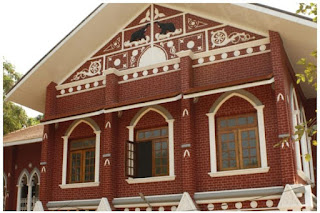 |
| College of Fine Arts, Kerala. T.V.Puram, upload.wikimedia.org |
Above image: The HH Maharajah school of Fine Arts on M.G. road, Palayam, Thiruvananthapuram was founded in 1888. Close to the State Central Library, it is a fine 2 story colonial structure that shows strong influence of native design with pointed arches, openings and doors in typical Gothic style. Exterior made of rich red sandstone with white stone dressings and fine ornamentation all around the arches, the porch, cast iron grill entrance gate at the main front facing the road and the painted parapet wall with grill work enhance the look of this old building. The first floor has extended tiled slanting roof with gables which have attractive wooden carvings. The carvings in the central gable are quite rich. The entrance gate carries the year of construction ie. 1888 CE. The building hosts a number of exhibitions every year by famous artists and sculptures. Two years ago, the building underwent a renovation..........
 |
| College of Fine Arts, Kerala. T.V.Puram, destimap.com |
Founded in 1881 by Moolam Thirunal Sir Rama Varma, the Maharaja of the state of Travancore, the School of Arts is one of the oldest institutions in Kerala exclusively devoted to fine arts. The ruler of the state was keenly interested in the vocational training of youngsters and expected them to learn technical skills so that they could make a living and run their family. Originally it was established as the ‘Dantha Āppis’ and the purpose was to train young young men to make ivory artefacts for the royals and top officials of the government. Kerala is still one of the Indian states with a large population of elephants.
The main red-colored building came up in 1888 to house the departments, etc.. The history of formal Western academic art education in Travancore can be traced back to the last decades of nineteenth century. The old Fine Arts College has close link with the Guild of ivory craftsmen of Travancore who did pioneering work in the past. There was a school for carving in ivory in the Huzur office functioning in1872-73, according to the Travancore State Manual.
During the later part of the 19th century the Dantha Āppis became a school of art and restructured on the model of the Madras School of Arts (present Government College of Fine Arts and Crafts, Egmore,Madras (now Chennai), Tamilnadu). In 1887-88 the Dantha Āppis became part of The Maharaja’s School of Arts and it gave priority to art and painting in the early 20th century. With the addition of other departments of wood carving, pottery and textile , the small campus became cramped. The campus at Palayam handled exclusively Painting, Sculpture and Applied Arts departments.
Here, all branches of arts and crafts were taught by experts. The courses included freehand drawing, model drawing, geometrical drawing, painting of all kinds, mural decoration, carving of ivory and carpentry, silversmith's work, pottery, carpet weaving and stained glass.
The statues of Dewan Madhava Rao (outside the Secretariat) and the Maharajah were made by a team from the fine arts school. It bears testimony to their quality training imparted in that institution. The school had two sections _ arts and industrial branch. The latter was associated with the production of lacquer work, kuft-gari, carving on wood, ivory, horn, coconut shell, pottery and porcelain
During the dewanship of Sir Madhava Rao and later his predecessor and relative T. Rama Rao 1887-92 gave priority and patronage to education.
After 1930s the institution came under the department of Industries despite protests from the public. In 1957 this old institution came under the department of Technical education when the first ever state democratically elected state government was formed after the princely state of Travancore had joined the Indian Union after 1948. Later it was affiliated to the University of Kerala,
The college offers UG and PG courses in fine arts- in painting and sculpture besides professional Bachelor of Fine Arts (BFA) courses (4 year program) in three disciplines: painting, sculpture and applied
In 1975, the institution was finally upgraded into the College of Fine Arts and became affiliated with the University of Kerala. In 2001 the college celebrated its silver jubilee year with exhibitions, seminars and workshops.














